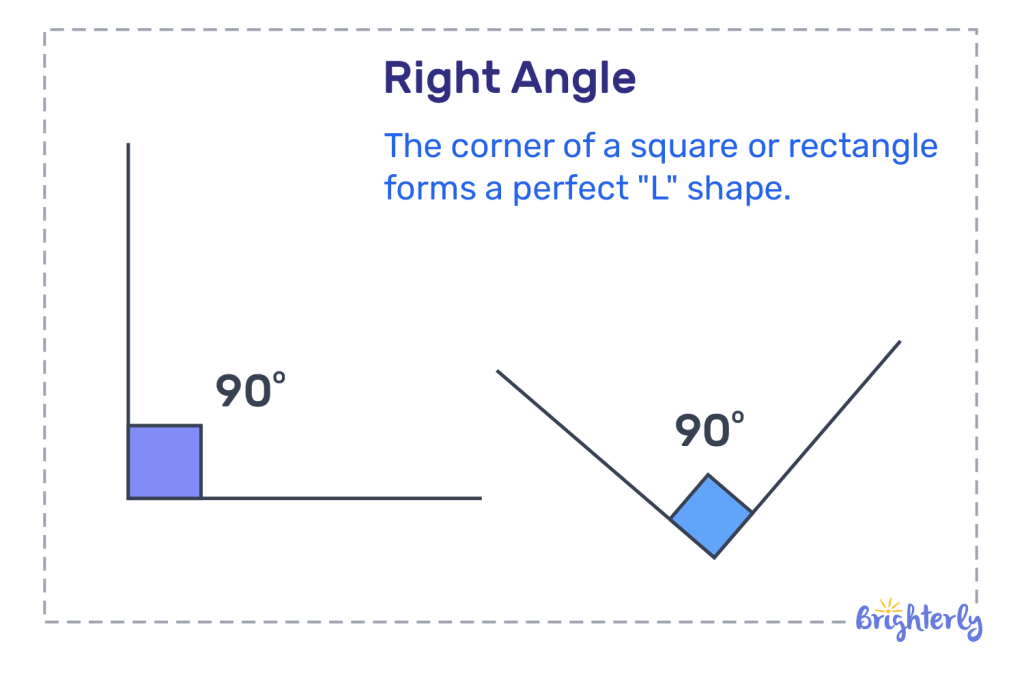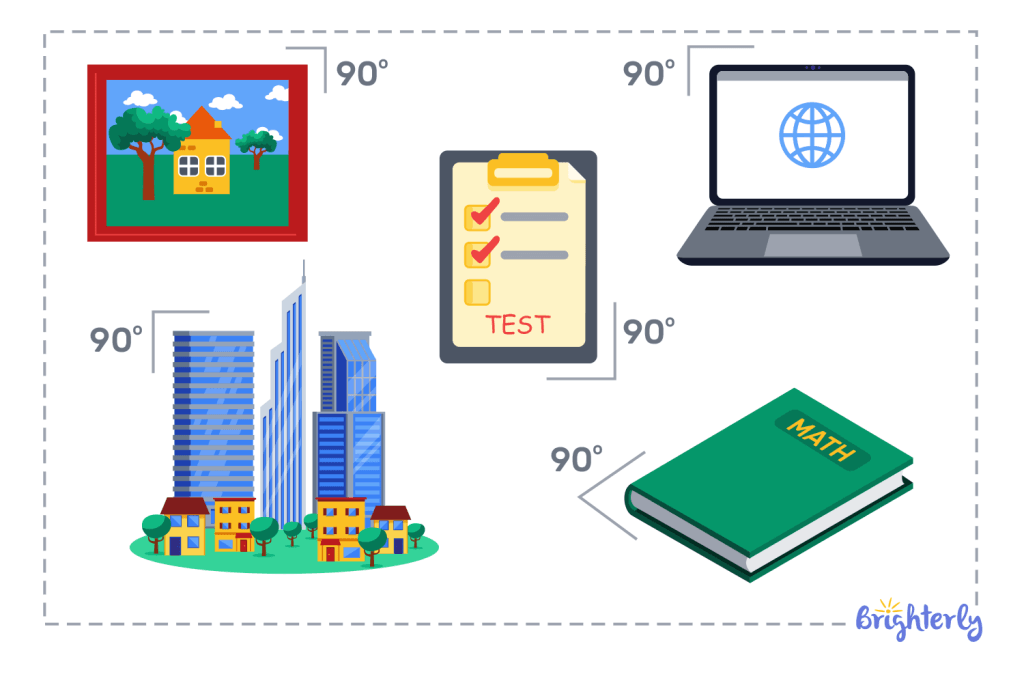Right Angle – Definition, Examples, Facts
Updated on November 28, 2025
From book corners and door edges to screens and table edges, right angles are everywhere we look. At Brighterly, we make math fun and easy by teaching children how to spot and understand angles. This article explains what a right angle is, how to identify it, and why it’s so important in geometry. In addition to building a strong foundation for more advanced math, it brings kids a deeper understanding of how the world works by comprehending right angles examples.
What is a right angle?
Right angle definition geometry says that it’s an angle measuring 90 degrees. The corner of a square or rectangle forms a perfect “L” shape. Geometrically speaking, right angles are common in everyday objects such as doors, windows, books, and tables.

Right angle shape
Shapes with right angles are called right-angled shapes. One or more angles of these shapes measure exactly 90 degrees, or right angles. You can spot a right angle by looking for a small square in the corner — it’s a simple way to recognize right angles in shapes quickly.
Right angle triangle
A right angle triangle has a 90-degree angle. An angle’s hypotenuse is always its longest side, opposite the right angle. The other two sides are called adjacent and opposite.
Right angle triangle formula
One of the most famous formulas for a right angle triangle is the Pythagorean theorem. It says that the square of the hypotenuse (the longest side, called c) equals the sum of the squares of the other two sides (a and b). In simple terms: a² + b² = c². This right angle math formula helps you find any side of a triangle if you know the other two.
Right angle triangle properties
Here are some simple facts about right-angled triangles that you might find useful:
- A triangle’s total angle is always 180 degrees. The other two angles must be less than 90 degrees because one is 90 degrees.
- The hypotenuse, which is always the longest side, is the side that is opposite the right angle.
- The Pythagorean theorem works for all shapes with right angles, making it a powerful tool in math and real-life problems.
Right angle triangle area
Use this formula to find the right angle triangle area:
Area = ½ × base × height.
Whenever a right angle is formed, the base and height are perpendicular to one another. By doing this, you can quickly and easily calculate the area.
Right angle isosceles triangle
There is a special kind of right angle triangle called an isosceles triangle, which has the same length on both sides of its right angle. The other two angles are also equal, each having 45 degrees.
How to draw a right angle using a protractor?
Drawing right angles is easier than it seems, helping you better understand right angle in shapes. You can use a protractor to make sure your angle is exactly 90 degrees. Follow these steps:
- On your paper, draw a straight line that is long enough to work with comfortably.
- Make sure the base of the protractor precisely aligns with your drawn line before placing its center hole at the end of the line.
- Make a tiny dot at the protractor’s 90-degree mark.
- Draw a straight line from the end of the first line to the dot after removing the protractor.
The more you try it, the easier it becomes to draw and spot right angle shapes everywhere around you.
Right angle in real life
Right angles are all around us, even if we don’t always notice them. They appear in many everyday objects, helping kids see what does a right angle look like. Here are some common examples:
- The corners of books and notebooks
- Door frames and window frames
- Tables and desks
- Picture frames and mirrors
- Tiles on floors or walls

By spotting right angles in these objects, children can easily connect geometry to the world around them and understand how right angle degrees appear in real life.
Solved examples on right angles
For children to understand right angles clearly, they should practice solving examples. Here are some easy ones to train with.
Example of right angle #1
Draw a square on paper. Each corner of the square is a right angle. Since a square has four corners, all four are 90 degrees. This shows how right angles appear in simple shapes.
Right angle rxamples #2
A rectangular door has corners that meet at 90 degrees. By checking each corner, you can see the right angle in action, making it easy to measure and understand.
Right angle real-life example #3
Look at a table in your room. The corners where the legs meet the tabletop are all right angles. Everyday objects like this help children recognize right angles in the real world.
Practice problems on right angles
Try these simple exercises for a better understanding right angle definition and example:
- Identify right angles in a notebook or book. How many corners have 90-degree angles?
- Draw a rectangle and mark all the right angles with a small square.
- Look around your room and list three objects that have right angles.
Conclusion
Geometry uses right angles a lot. Furthermore, right angles are found in many common shapes, such as squares and rectangles, and are essential for understanding more complex geometric concepts. By identifying right angle definition and knowing how to find the shape in everyday objects, such as books, doors, and picture frames, children can develop a strong foundation in geometry and apply it to problem-solving in various contexts.
Frequently asked questions on right angle
What are right angles?
Right angles are angles that measures exactly 90 degrees. It forms a perfect “L” shape and appears in many objects, drawings, and geometric shapes.
What degree is a right angle?
A right angle always measures exactly 90 degrees. It is one of the most common and important angles in geometry, and it helps in creating squares, rectangles, and other shapes with perpendicular sides.
Why is a right angle called a right angle?
A right angle is called a right angle because it represents a “correct” or “proper” angle in geometry, forming a perfect corner that is perpendicular. This term comes from the idea of being straight and exact.
What shapes have a right angle?
Shapes that have right angles include squares, rectangles, and right-angled triangles.






